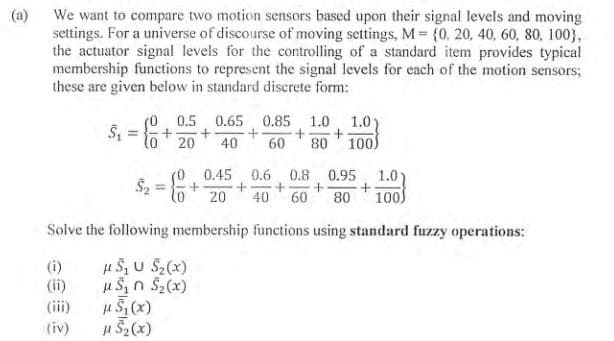We want to compare two motion sensors based upon their signal levels and moving settings. For a universe of discourse of moving settings, M= {0, 20, 40, 60, 80, 100), the actuator signal levels for the controlling of a standard item provides typical membership functions to represent the signal levels for each of the motion sensors; these are given below in standard discrete form: (0 0.5 0.65 0.85 1.0, 1.0) S₁ + + 20 40 80 +100 + 60 (ii) (iii) 5₂ = 1+ 0.45 0.6 0.8 0.95 1.0) + + + + 20 40 60 80 100 Solve the following membership functions using standard fuzzy operations: μS₁ U S₂(x) μ S₁ S₂(x) μl S₁ (x)
We want to compare two motion sensors based upon their signal levels and moving settings. For a universe of discourse of moving settings, M= {0, 20, 40, 60, 80, 100), the actuator signal levels for the controlling of a standard item provides typical membership functions to represent the signal levels for each of the motion sensors; these are given below in standard discrete form: (0 0.5 0.65 0.85 1.0, 1.0) S₁ + + 20 40 80 +100 + 60 (ii) (iii) 5₂ = 1+ 0.45 0.6 0.8 0.95 1.0) + + + + 20 40 60 80 100 Solve the following membership functions using standard fuzzy operations: μS₁ U S₂(x) μ S₁ S₂(x) μl S₁ (x)
Advanced Engineering Mathematics
10th Edition
ISBN:9780470458365
Author:Erwin Kreyszig
Publisher:Erwin Kreyszig
Chapter2: Second-order Linear Odes
Section: Chapter Questions
Problem 1RQ
Related questions
Question

Transcribed Image Text:(a)
We want to compare two motion sensors based upon their signal levels and moving
settings. For a universe of discourse of moving settings, M = {0, 20, 40, 60, 80, 100),
the actuator signal levels for the controlling of a standard item provides typical
membership functions to represent the signal levels for each of the motion sensors;
these are given below in standard discrete form:
(0 0.5 0.65 0.85 1.0
+
+ +
20 40 60 80
(i)
(ii)
(iii)
(iv)
5₁ = { +
$₂
=
μ 5₁ (x)
μ S₂ (x)
1.0)
100)
Solve the following membership functions using standard fuzzy operations:
μ S₁ U S₂(x)
μS₁ S₂(x)
0.45 0.6 0.8 0.95 1.0)
+ + +
+
20 40 60 80 100)

Transcribed Image Text:8
(vi)
μ S₁ U S₂(x)
μS, n 5₂(x)
Expert Solution
This question has been solved!
Explore an expertly crafted, step-by-step solution for a thorough understanding of key concepts.
Step by step
Solved in 2 steps

Recommended textbooks for you

Advanced Engineering Mathematics
Advanced Math
ISBN:
9780470458365
Author:
Erwin Kreyszig
Publisher:
Wiley, John & Sons, Incorporated

Numerical Methods for Engineers
Advanced Math
ISBN:
9780073397924
Author:
Steven C. Chapra Dr., Raymond P. Canale
Publisher:
McGraw-Hill Education

Introductory Mathematics for Engineering Applicat…
Advanced Math
ISBN:
9781118141809
Author:
Nathan Klingbeil
Publisher:
WILEY

Advanced Engineering Mathematics
Advanced Math
ISBN:
9780470458365
Author:
Erwin Kreyszig
Publisher:
Wiley, John & Sons, Incorporated

Numerical Methods for Engineers
Advanced Math
ISBN:
9780073397924
Author:
Steven C. Chapra Dr., Raymond P. Canale
Publisher:
McGraw-Hill Education

Introductory Mathematics for Engineering Applicat…
Advanced Math
ISBN:
9781118141809
Author:
Nathan Klingbeil
Publisher:
WILEY

Mathematics For Machine Technology
Advanced Math
ISBN:
9781337798310
Author:
Peterson, John.
Publisher:
Cengage Learning,

